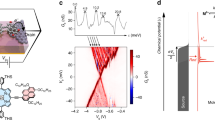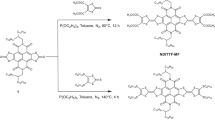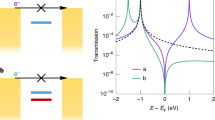Abstract
Metal/organic interfaces critically determine the characteristics of molecular electronic devices, because they influence the arrangement of the orbital levels that participate in charge transport. Studies on self-assembled monolayers show molecule-dependent energy-level shifts as well as transport-gap renormalization, two effects that suggest that electric-field polarization in the metal substrate induced by the formation of image charges plays a key role in the alignment of the molecular energy levels with respect to the metal's Fermi energy. Here, we provide direct experimental evidence for an electrode-induced gap renormalization in single-molecule junctions. We study charge transport through single porphyrin-type molecules using electrically gateable break junctions. In this set-up, the position of the occupied and unoccupied molecular energy levels can be followed in situ under simultaneous mechanical control. When increasing the electrode separation by just a few ångströms, we observe a substantial increase in the transport gap and level shifts as high as several hundreds of meV. Analysis of this large and tunable gap renormalization based on atomic charges obtained from density functional theory confirms and clarifies the dominant role of image-charge effects in single-molecule junctions.
This is a preview of subscription content, access via your institution
Access options
Subscribe to this journal
Receive 12 print issues and online access
$259.00 per year
only $21.58 per issue
Buy this article
- Purchase on Springer Link
- Instant access to full article PDF
Prices may be subject to local taxes which are calculated during checkout





Similar content being viewed by others
References
Ishii, H., Sugiyama, K., Ito, E. & Seki, K. Energy level alignment and interfacial electronic structures at organic/metal and organic/organic interfaces. Adv. Mater. 11, 605–625 (1999).
Koch, N. Energy levels at interfaces between metals and conjugated organic molecules. J. Phys. Condens. Matter 20, 184008 (2008).
Braun, S., Salaneck, W. R. & Fahlman, M. Energy-level alignment at organic/metal and organic/organic interfaces. Adv. Mater. 21, 1450–1472 (2009).
Hwang, J., Wan, A. & Kahn, A. Energetics of metal–organic interfaces: new experiments and assessment of the field. Mater. Sci. Eng. R 64, 1–31 (2009).
Lange, I. et al. Band bending in conjugated polymer layers. Phys. Rev. Lett. 106, 216402 (2011).
Broker, B. et al. Density-dependent reorientation and rehybridization of chemisorbed conjugated molecules for controlling interface electronic structure. Phys. Rev. Lett. 104, 246805 (2010).
Otsuki, J. STM studies on porphyrins. Coord. Chem. Rev. 254, 2311–2341 (2010).
Ishii, H. et al. Energy level alignment and band bending at model interfaces of organic electroluminescent devices. J. Lumin. 61, 87–89 (2000).
Heimel, G., Romaner, L., Zojer, E. & Bredas, J-L. The interface energetics of self-assembled monolayers on metals. Acc. Chem. Res. 41, 721–729 (2008).
Bruot, C., Hihath, J. & Tao, N. Mechanically controlled molecular orbital alignment in single molecule junctions. Nature Nanotech. 7, 35–40 (2012).
Romaner, L., Heimel, G., Gruber, M., Bredas, J-L. & Zojer, E. Stretching and breaking of a molecular junction. Small 2, 1468–1475 (2006).
Amy, F., Chan, C. & Kahn, A. Polarization at the gold/pentacene interface. Org. Electron. 6, 85–91 (2005).
Kubatkin, S. et al. Single-electron transistor of a single organic molecule with access to several redox states. Nature 425, 698–701 (2003).
Osorio, E. et al. Addition energies and vibrational fine structure measured in electromigrated single-molecule junctions based on an oligophenylenevinylene derivative. Adv. Mater. 19, 281–285 (2007).
Kaasbjerg, K. & Flensberg, K. Strong polarization-induced reduction of addition energies in single-molecule nanojunctions. Nano Lett. 8, 3809–3814 (2008).
Thygesen, K. S. & Rubio, A. Renormalization of molecular quasiparticle levels at metal–molecule interfaces: trends across binding regimes. Phys. Rev. Lett. 102, 046802 (2009).
Barr, J. D., Stafford, C. A. & Bergfield, J. P. Effective field theory of interacting π electrons. Phys. Rev. B 86, 115403 (2012).
Champagne, A., Pasupathy, A. & Ralph, D. Mechanically adjustable and electrically gated single-molecule transistors. Nano Lett. 5, 305–308 (2005).
Martin, C. A., van Ruitenbeek, J. M. & van der Zant, H. S. J. Sandwich-type gated mechanical break junctions. Nanotechnology 21, 265201 (2010).
Parks, J. J. et al. Mechanical control of spin states in spin-1 molecules and the underscreened kondo effect. Science 328, 1370–1373 (2010).
Meisner, J. S. et al. A single-molecule potentiometer. Nano Lett. 11, 1575–1579 (2011).
Toher, C. et al. Electrical transport through a mechanically gated molecular wire. Phys. Rev. B 83, 155402 (2011).
Kim, Y. et al. Conductance and vibrational states of single-molecule junctions controlled by mechanical stretching and material variation. Phys. Rev. Lett. 106, 196804 (2011).
Van Ruitenbeek, J. M. et al. Adjustable nanofabricated atomic size contacts. Rev. Sci. Instrum. 67, 108–111 (1996).
Kergueris, C. et al. Electron transport through a metal–molecule–metal junction. Phys. Rev. B 59, 12505–12513 (1999).
Reichert, J., Ochs, R., Beckmann, D., Weber, H. B., Mayor, M. & von Lohneysen, H. Driving current through single organic molecules. Phys. Rev. Lett. 88, 176804 (2002).
Dulić, D. et al. One-way optoelectronic switching of photochromic molecules on gold. Phys. Rev. Lett. 91, 207402 (2003).
Martin, C. et al. Fullerene-based anchoring groups for molecular electronics. J. Am. Chem. Soc. 130, 13198–13199 (2008).
Ruben, M. et al. Charge transport through a cardan-joint molecule. Small 4, 2229–2235 (2008).
Wu, S. et al. Molecular junctions based on aromatic coupling. Nature Nanotech. 3, 569–574 (2008).
Cuevas, J. C. & Scheer, E. Molecular Electronics: An Introduction to Theory and Experiment Ch. 13 (World Scientific, 2010).
Perrin, M. et al. Charge transport in a zinc-porphyrin single-molecule junction. Beilstein J. Nanotechnol. 2, 714–719 (2011).
Dulić, D. et al. Controlled stability of molecular junctions. Angew. Chem. Int. Ed. 48, 8273–8276 (2009).
Perrin, M. et al. Influence of the chemical structure on the stability and conductance of porphyrin single-molecule junctions. Angew. Chem. Int. Ed. 50, 11223–11226 (2011).
Verzijl, C. J. O. & Thijssen, J. M. A DFT-based molecular transport implementation in ADF/band. J. Phys. Chem. C 116, 24393–24412 (2012).
Xue, Y. & Ratner, M. Microscopic theory of single-electron tunneling through molecular-assembled metallic nanoparticles. Phys. Rev. B 68, 115406 (2003).
Nara, J., Geng, W. T., Kino, H., Kobayashi, N. & Ohno, T. Theoretical investigation on electron transport through an organic molecule: effect of the contact structure. J. Chem. Phys. 121, 6485–6492 (2004).
Pontes, R. B., Rocha, A. R., Sanvito, S., Fazzio, A. & da Silva, A. J. R. Ab initio calculations of structural evolution and conductance of benzene-1,4-dithiol on gold leads. ACS Nano 5, 795–804 (2011).
Garcia-Lastra, J. M., Rostgaard, C., Rubio, A. & Thygesen, K. S. Polarization-induced renormalization of molecular levels at metallic and semiconducting surfaces. Phys. Rev. B 80, 245427 (2009).
Myohanen, P., Tuovinen, R., Korhonen, T., Stefanucci, G. & van Leeuwen, R. Image charge dynamics in time-dependent quantum transport. Phys. Rev. B 85, 075105 (2012).
Martin, R. M. Electronic Structure: Basic Theory and Practical Methods Ch. 10 (Cambridge Univ. Press, 2004).
Smith, N., Chen, C. & Weinert, M. Distance of the image plane from metal surfaces. Phys. Rev. B 40, 7565–7573 (1989).
Quek, S. et al. Amine–gold linked single-molecule circuits: experiment and theory. Nano Lett. 11, 3477–3482 (2007).
Kaasbjerg, K. & Flensberg, K. Image charge effects in single-molecule junctions: breaking of symmetries and negative-differential resistance in a benzene single-electron transistor. Phys. Rev. B 84, 115457 (2011).
Neaton, J. B., Hybertsen, M. S. & Louie, S. G. Renormalization of molecular electronic levels at metal–molecule interfaces. Phys. Rev. Lett. 97, 216405 (2006).
Mowbray, D. J., Jones, G. & Thygesen, K. S. Influence of functional groups on charge transport in molecular junctions. J. Chem. Phys. 128, 111103 (2008).
Acknowledgements
This research was carried out with financial support from the Dutch Foundation for Fundamental Research on Matter (FOM) and the European Union Seventh Framework Programme (FP7/2007-2013, under grant agreement no 270369, ‘ELFOS’). The authors would like to thank R. van Egmond for expert technical support and J. S. Seldenthuis for fruitful discussions.
Author information
Authors and Affiliations
Contributions
D.D. and H.v.d.Z. designed the project. C.M., H.v.d.Z. and J.v.R. designed the set-up and the devices. M.P. and C.M. fabricated the devices. A.S., R.E. and J.v.E provided the molecules. M.P and D.D. performed the experiments. C.V., M.P. and J.T. performed the calculations. M.P., C.V., D.D., J.T. and H.v.d.Z. wrote the manuscript. All authors discussed the results and commented on the manuscript.
Corresponding author
Ethics declarations
Competing interests
The authors declare no competing financial interests.
Supplementary information
Supplementary information
Supplementary information (PDF 3015 kb)
Rights and permissions
About this article
Cite this article
Perrin, M., Verzijl, C., Martin, C. et al. Large tunable image-charge effects in single-molecule junctions. Nature Nanotech 8, 282–287 (2013). https://doi.org/10.1038/nnano.2013.26
Received:
Accepted:
Published:
Issue Date:
DOI: https://doi.org/10.1038/nnano.2013.26
This article is cited by
-
First-Principles Approach to Elucidating Significant Rectification Ratios in Oppositely Charged Dipeptides
Journal of Electronic Materials (2024)
-
In-situ electro-responsive through-space coupling enabling foldamers as volatile memory elements
Nature Communications (2023)
-
Computational evaluation of transport parameters and logic circuit designing of L-Lysine amino acid stringed to Au, Ag, Cu, Pt, and Pd electrodes
Journal of Molecular Modeling (2023)
-
Plasmonic phenomena in molecular junctions: principles and applications
Nature Reviews Chemistry (2022)
-
Reversible switching of Kondo resonance in a single-molecule junction
Nano Research (2022)



